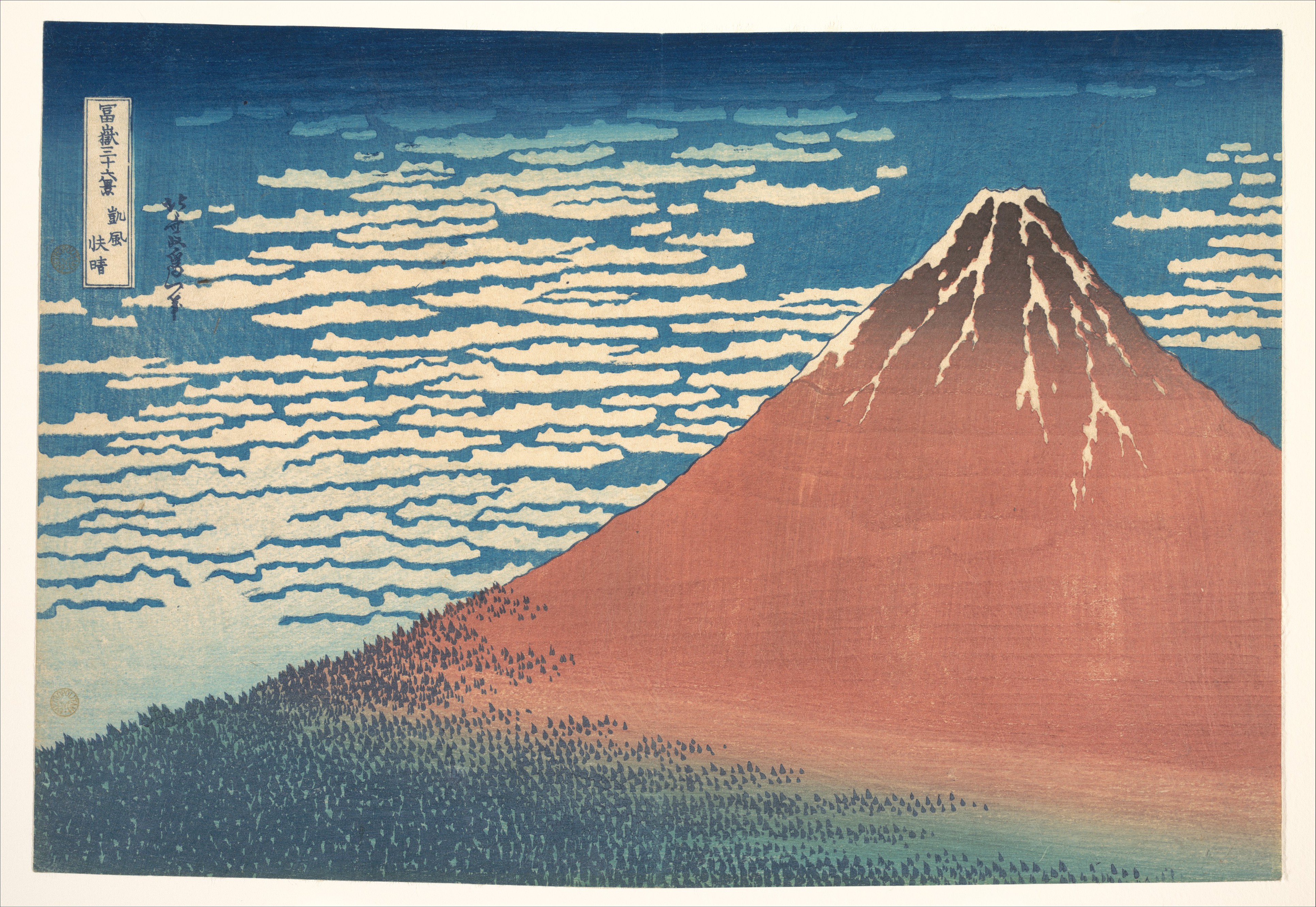You must join the virtual exhibition queue when you arrive. If capacity has been reached for the day, the queue will close early.
Learn more
Jump to content tickets Member | Make a donation
- The Collection
- The American Wing Ancient Near Eastern Art Arms and Armor The Michael C. Rockefeller Wing Asian Art The Cloisters The Costume Institute Drawings and Prints Egyptian Art European Paintings European Sculpture and Decorative Arts Greek and Roman Art Islamic Art Robert Lehman Collection The Libraries Medieval Art Musical Instruments Photographs Antonio Ratti Textile Center Modern and Contemporary Art
Crop your artwork:
Scan your QR code:
Gratefully built with ACNLPatternTool
Katsushika Hokusai Japanese
Not on view
Hokusai's "Thirty-six Views of Mount Fuji" is justly celebrated as one of the world's greatest series of images of various conditions and vantage points of a particular place, in this case, the mountain synonymous with Japan. Juxtaposed here with the clear brilliant calm of "South Wind, Clear Sky" (the "Red Fuji"), the Storm Below Fuji reveals the expressive range and power of Hokusai's vision. Forky across the inky base, a bolt of white lightning dramatizes the sudden change from a cloud filled summer sky to the murky violence that obscures all below Fuji's magnificent cone.
This series created such a sensation that the publisher Eijudo expanded the original conception to eventually include forty-six prints in this series. Another version pulled from the same block includes a line of trees, dimly visible in the rain below the mountain, but this print more effectively implies the awesome moment of the summer storm by eliminating this explicit depiction of rain.
This series is noted for its particular blue color, called "Berlin indigo" (bero-ai), a pigment newly introduced by Dutch merchants.
Open Access
As part of the Met's Open Access policy, you can freely copy, modify and distribute this image, even for commercial purposes.
API
Public domain data for this object can also be accessed using the Met's Open Access API.
- Download image
Artwork Details
Use your arrow keys to navigate the tabs below, and your tab key to choose an item
「富嶽三十六景 凱風快晴」
Title: South Wind, Clear Sky (Gaifū kaisei), also known as Red Fuji, from the series Thirty-six Views of Mount Fuji (Fugaku sanjūrokkei)
Artist: Katsushika Hokusai (Japanese, Tokyo (Edo) 1760–1849 Tokyo (Edo))
Period: Edo period (1615–1868)
Date: ca. 1830–32
Culture: Japan
Medium: Woodblock print; ink and color on paper
Dimensions: 9 5/8 x 14 in. (24.4 x 35.6 cm)
Classification: Prints
Credit Line: Rogers Fund, 1914
Accession Number: JP9
Learn more about this artwork
Timeline of Art History
Essay
Art of the Edo Period (1615-1868)
Essay
Art of the Pleasure Quarters and the Ukiyo-e Style
Essay
Japonisme
Essay
Woodblock Prints in the Ukiyo-e Style
Chronology
Japan, 1800-1900 A.D.
Related Artworks
- All Related Artworks
- By Katsushika Hokusai
- Asian Art
- Ink
- Paper
- Printing blocks
- Prints
- Relief prints
- Wood blocks
- Woodcuts
- From Asia
- From Japan
- From A.D. 1800–1900
South Wind, Clear Sky (Gaifū kaisei), also known as Red Fuji, from the series Thirty-six Views of Mount Fuji (Fugaku sanjūrokkei)
Katsushika Hokusai (Japanese, Tokyo (Edo) 1760–1849 Tokyo (Edo))
ca. 1830–32
South Wind, Clear Sky (Gaifū kaisei), also known as Red Fuji, from the series Thirty-six Views of Mount Fuji (Fugaku sanjūrokkei)
Katsushika Hokusai (Japanese, Tokyo (Edo) 1760–1849 Tokyo (Edo))
ca. 1830–32
Yahagi Bridge at Okazaki on the Tōkaidō (Tōkaidō Okazaki Yahagi no hashi), from the series Remarkable Views of Bridges in Various Provinces (Shokoku meikyō kiran)
Katsushika Hokusai (Japanese, Tokyo (Edo) 1760–1849 Tokyo (Edo))
ca. 1834
The Suspension Bridge on the Border of Hida and Etchū Provinces (Hietsu no sakai tsuribashi), from the series Remarkable Views of Bridges in Various Provinces (Shokoku meikyō kiran)
Katsushika Hokusai (Japanese, Tokyo (Edo) 1760–1849 Tokyo (Edo))
ca. 1830
Viewing the Sunset over Ryōgoku Bridge from the Onmayagashi Embankment (Onmayagashi yori Ryōgokubashi sekiyō o miru), from the series Thirty-six Views of Mount Fuji (Fugaku sanjūrokkei)
Katsushika Hokusai (Japanese, Tokyo (Edo) 1760–1849 Tokyo (Edo))
ca. 1830–32
Resources for Research
The Met's Libraries and Research Centers provide unparalleled resources for research and welcome an international community of students and scholars.
The Met Collection API is where all makers, creators, researchers, and dreamers can connect to the most up-to-date data and public domain images for The Met collection. Open Access data and public domain images are available for unrestricted commercial and noncommercial use without permission or fee.
Feedback
We continue to research and examine historical and cultural context for objects in The Met collection. If you have comments or questions about this object record, please complete and submit this form. The Museum looks forward to receiving your comments.
Asian Art at The Met
The Met's collection of Asian art—more than 35,000 objects, ranging in date from the third millennium B.C. to the twenty-first century—is one of the largest and most comprehensive in the world.
